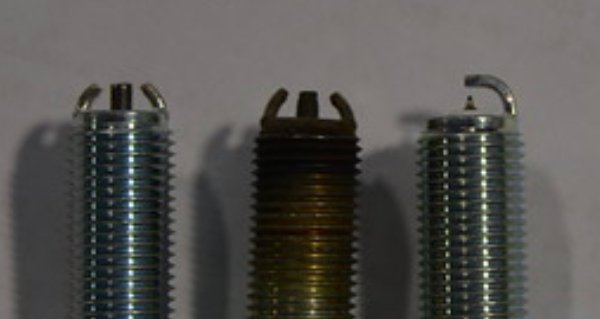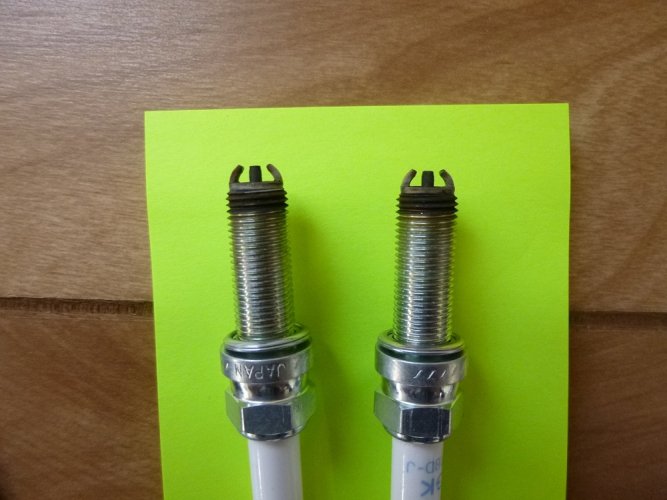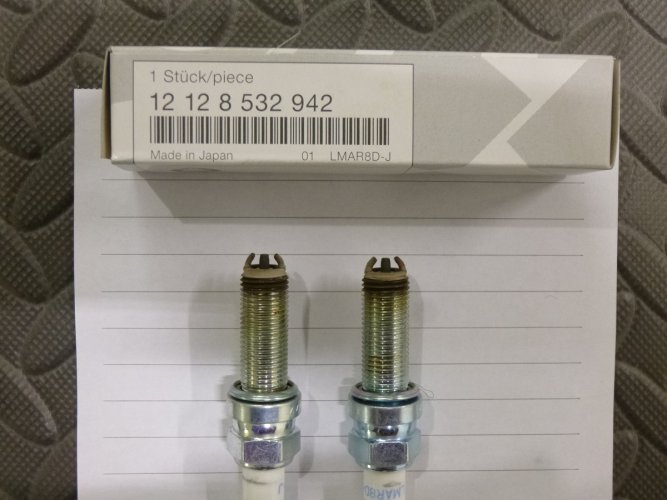Has anybody been using Iridium spark plugs in the wetheads? I spoke to the NGK technical rep, he informed me that the Iridium equivalent (NGK LMAR8AI-8) would effectively replace the standard plug (NGK LMAR8D-J), give longer life and be slightly better for performance and economy. I am interested in hearing any comments. BMW's recommendation to change plugs every 6 thousand miles seems like overkill.
Navigation
Install the app
How to install the app on iOS
Follow along with the video below to see how to install our site as a web app on your home screen.
Note: This feature may not be available in some browsers.
More options
-
Welcome, Guest! We hope you enjoy the excellent technical knowledge, event information and discussions that the BMW MOA forum provides. Some forum content will be hidden from you if you remain logged out. If you want to view all content, please click the 'Log in' button above and enter your BMW MOA username and password. If you are not an MOA member, why not take the time to join the club, so you can enjoy posting on the forum, the BMW Owners News magazine, and all of the discounts and benefits the BMW MOA offers?
-
Beginning April 1st, and running through April 30th, there is a new 2024 BMW MOA Election discussion area within The Club section of the forum. Within this forum area is also a sticky post that provides the ground rules for participating in the Election forum area. Also, the candidates statements are provided. Please read before joining the conversation, because the rules are very specific to maintain civility.
The Election forum is here: Election Forum
You are using an out of date browser. It may not display this or other websites correctly.
You should upgrade or use an alternative browser.
You should upgrade or use an alternative browser.
Iridium spark plugs in the wetheads
- Thread starter slam.bob
- Start date
alancoles
Dress for fall & avoid it
I'm running them and everything is fine. Just put them in so can't say how they'll last, however, BoxFlyer (on here) has been running them for some time and reports very good extended life compared to the OE plug. His wear was marginal at the most recent Scheduled Maintenance change point to the point that he decided to keep them in until the next schedule (IIRC).
When I changed my OE plugs were well worn by 17,000 miles.
I've not spoken to an NGK rep for several years, but it is my understanding that the newer plugs are designed to not need re-gapping but to be replaced when they're worn to the point of needing re-gapping, and that is why BMW specs the plug gap on Wetheads at: "0.8±0.1 mm when new and 1.0 mm Wear limit" so change plugs when the electrode has worn down from 0.8mm (0.032") to a gap of 0.9mm (0.035"). The manual says the intial gap setting between 0.7mm and 0.9mm is fine but that wear of 0.1mm is the replacement point. That's another reason to measure and record your initial gap.
When I changed my OE plugs were well worn by 17,000 miles.
I've not spoken to an NGK rep for several years, but it is my understanding that the newer plugs are designed to not need re-gapping but to be replaced when they're worn to the point of needing re-gapping, and that is why BMW specs the plug gap on Wetheads at: "0.8±0.1 mm when new and 1.0 mm Wear limit" so change plugs when the electrode has worn down from 0.8mm (0.032") to a gap of 0.9mm (0.035"). The manual says the intial gap setting between 0.7mm and 0.9mm is fine but that wear of 0.1mm is the replacement point. That's another reason to measure and record your initial gap.
Spark Plug Service Interval - 2016 R1200RS
Bob,
The service interval for the spark plugs on our 2016 R1200RS LC per the owner's manual is 20,000 klicks or 12,000 miles.
I ran the NGK equivalent of the BMW NGK plug required for our 2008 K1200GT with no problem. After several years they even got cheaper.
Bob,
The service interval for the spark plugs on our 2016 R1200RS LC per the owner's manual is 20,000 klicks or 12,000 miles.
I ran the NGK equivalent of the BMW NGK plug required for our 2008 K1200GT with no problem. After several years they even got cheaper.
Boxflyer
Active member
Iridium NGK
13,000 miles on the first set of the NGK Iridium plugs in the RT-LC was all that they would take. The ground electrode has an iridium pad, and the end of the center electrode is iridium, neither show much erosion, but the center electrode between the ceramic insulator and the iridium tip started to show loss of metal. I was afraid that this small piece of the tip of the electrode would break off and could be lodged between the piston and the cylinder or do some other damage, so they were replaced with a fresh set of them.
I didn't feel any difference in performance, starting, or fuel mileage, between OEM plugs (NGK LMAR8D-J) and the iridium plugs that are 1 numerical heat range cooler (NGK LMAR9AI-8). LMAR8 vs LMAR9, with the number showing the heat range.
Prices for OEM plugs early in 2018 were very HIGH at about $28 each online and I could get the iridium plugs for $13.50 here https://www.amazon.com/gp/product/B0068O6BA0/ref=oh_aui_detailpage_o00_s00?ie=UTF8&psc=1
Now the OEM plugs can be found online for less than the iridium plugs, so I don't think it makes a difference one way or the other which you use. https://www.amazon.com/NGK-93444-LMAR8D-J-Standard-Spark/dp/B00DZQ69BA
The WetHead seems to be hard on plugs...(I think all the boxers are)...I feel that 12,000miles is all that either type of plug can go, and I will follow the MFG's recommended replacement interval and use either one. (It has to be some kind of placebo effect to feel any difference with a "butt-dyno")
First pic is AlanColes old OEM plug (17,000miles) in the middle, flanked by a new OEM plug and an iridium plug. Pretty bad erosion of both the center electrode and ground prongs.
Second picture is of the iridium plug at the 6,000mile point.
Third picture is the same iridium plug at the 13,000mile point that has undercut metal on the center electrode.



13,000 miles on the first set of the NGK Iridium plugs in the RT-LC was all that they would take. The ground electrode has an iridium pad, and the end of the center electrode is iridium, neither show much erosion, but the center electrode between the ceramic insulator and the iridium tip started to show loss of metal. I was afraid that this small piece of the tip of the electrode would break off and could be lodged between the piston and the cylinder or do some other damage, so they were replaced with a fresh set of them.
I didn't feel any difference in performance, starting, or fuel mileage, between OEM plugs (NGK LMAR8D-J) and the iridium plugs that are 1 numerical heat range cooler (NGK LMAR9AI-8). LMAR8 vs LMAR9, with the number showing the heat range.
Prices for OEM plugs early in 2018 were very HIGH at about $28 each online and I could get the iridium plugs for $13.50 here https://www.amazon.com/gp/product/B0068O6BA0/ref=oh_aui_detailpage_o00_s00?ie=UTF8&psc=1
Now the OEM plugs can be found online for less than the iridium plugs, so I don't think it makes a difference one way or the other which you use. https://www.amazon.com/NGK-93444-LMAR8D-J-Standard-Spark/dp/B00DZQ69BA
The WetHead seems to be hard on plugs...(I think all the boxers are)...I feel that 12,000miles is all that either type of plug can go, and I will follow the MFG's recommended replacement interval and use either one. (It has to be some kind of placebo effect to feel any difference with a "butt-dyno")
First pic is AlanColes old OEM plug (17,000miles) in the middle, flanked by a new OEM plug and an iridium plug. Pretty bad erosion of both the center electrode and ground prongs.
Second picture is of the iridium plug at the 6,000mile point.
Third picture is the same iridium plug at the 13,000mile point that has undercut metal on the center electrode.



For the sake of argument, let’s say the manual was never read and the bike was just run......
When would the rider notice the results of not changing the spark plugs at recommend intervals?
What would those symptoms be?
How far does the group think they could really go on a set of plugs?
OM
When would the rider notice the results of not changing the spark plugs at recommend intervals?
What would those symptoms be?
How far does the group think they could really go on a set of plugs?
OM
Boxflyer
Active member
Kevin, I agree...
Fresh plugs in at each 12K service is what is called for and probably for lots of reasons.
One reason, besides insuring that deposits on ceramic parts and electrodes are eliminated, would be that the increased gap that the spark has to jump could cause stress on the stick coil internals.
I'm not sure about that, and I've not seen a stick coil fail on the wethead, but the cost of new plugs is low if they could cause a stick coil failure.
Fresh plugs in at each 12K service is what is called for and probably for lots of reasons.
One reason, besides insuring that deposits on ceramic parts and electrodes are eliminated, would be that the increased gap that the spark has to jump could cause stress on the stick coil internals.
I'm not sure about that, and I've not seen a stick coil fail on the wethead, but the cost of new plugs is low if they could cause a stick coil failure.
pglaves
#13338
Cadillac specifies a plug change at 100,000 miles.
BMW motorcycles has specified a 12,000 mile interval for as long as I can remember, certainly back to the brown coil vs blue coil days of the Airheads. So I don't really suspect it relates to stick coils.
Symptoms would probably start with a decrease in fuel mileage even before detectable misfire. Then slight misfire and hard starting.
BMW motorcycles has specified a 12,000 mile interval for as long as I can remember, certainly back to the brown coil vs blue coil days of the Airheads. So I don't really suspect it relates to stick coils.
Symptoms would probably start with a decrease in fuel mileage even before detectable misfire. Then slight misfire and hard starting.
My old 2001 BMW 3.0L Z3 specifies plug changes at 100k mile. The total number of sparks/mile are similar as the Z3 turns only a bit fewer RPMs at 60mph.
Can any one share some facts (physics 1st principals) why the need for change motorcycle plug so frequently?
Right now I think changing at 12000 miles is BS.
Can any one share some facts (physics 1st principals) why the need for change motorcycle plug so frequently?
Right now I think changing at 12000 miles is BS.
Very interesting to see the different experiences and opinions. Being a maintenance fanatic I will change the plugs every 12000mi as specified , A pair of Iridiums have arrive at my door so they will get a try. The NGK rep was sure that there would be no downside to using the iridums, hope he is right.
It probably doesn't apply, but on my Harley I ran a set of standard spark plugs to 30,000 miles and took a good look at them and ran them to 45,000 miles. At 30k they looked great, tough to see any wear on them. At 45k they were past due. So for whatever it is worth the 12k charge is B.S. I would run twice that before ever thinking about changing them.
bobsguns
New member
My old 2001 BMW 3.0L Z3 specifies plug changes at 100k mile. The total number of sparks/mile are similar as the Z3 turns only a bit fewer RPMs at 60mph.
Can any one share some facts (physics 1st principals) why the need for change motorcycle plug so frequently?
Right now I think changing at 12000 miles is BS.
Compression.
Much higher compression on a 1200 (or most bikes for that matter) than a standard vehicle. BMW's are 12:1 (IIRC) & most cars/trucks are in the 8:1 or 9:1 range if I'm not mistaken. Someone correct me if I'm wrong here.
Higher compression = more strain on a plug.
bobsguns
New member
I change stuff (fluids, filters, plugs) when the maintenance schedule calls for change. To do otherwise seems penny wise and pound foolish.
Well, plugs aren't quite the same as fluids, IMO.
German engineering being what it is, I sometimes wonder if the 12k interval isn't also geared towards making the dealer some $$ ?
pglaves
#13338
Well, plugs aren't quite the same as fluids, IMO.
German engineering being what it is, I sometimes wonder if the 12k interval isn't also geared towards making the dealer some $$ ?
On topic: BMW tends to call for many services to be performed at one time. In a general sense this saves time and money. Somewhat off topic: Many folks used to riding Airheads tended to do a "service" over several evenings or weekends. Oil change one week, ignition tune another week, etc.
So, at one of the annual Tech Days we held for the Kansas City and Topeka clubs in Kansas one rider on his new-to-him K1200LT showed up to "just" replace his air filter. So in one corner several folks began taking off plastic, the fuel tank, and a whole bunch of other parts to access the air cleaner. Meanwhile, over in the "clean room" on the lift three or four folks installed new rings on a something /7. They were finished first.
I am firmly convinced that when the K1200LT began down the assembly line the first part on the line was the air cleaner, around which the entire rest of the bike was assembled. YMMV.
alancoles
Dress for fall & avoid it
Compression ratios are much higher than that now.Compression.
Much higher compression on a 1200 (or most bikes for that matter) than a standard vehicle. BMW's are 12:1 (IIRC) & most cars/trucks are in the 8:1 or 9:1 range if I'm not mistaken. Someone correct me if I'm wrong here.
Higher compression = more strain on a plug.
Yes higher compression will reduce lifespan, but that's not the case for most cars now unless you look at the "static" compression for tubro-charged cars whose actual working compression ratio is above 12:1. Even my 8 year old Lincoln MKZ with it's 3.5L V6 has a 10.5:1 CR and the new 3.5L runs 12:1.
Most car engines are running 11.5:1 to 12:1 today with rev limits at 6,500 to 7,500, so as the OP mentioned, not far off his 3L Z3. My old Z3 M-Coupe ran an 11.5:1 CR.
My 2019 Mustang Bullitt runs a 12.1:1 compression ratio and makes 480HP @ 7,000 rpm with a rev limit around 7,500, from 5L and has a 100,000 mile replacement schedule for plugs. So virtually the same compression ratio as an R1200RTW and about the same power/displacement but, the Mustang has to move 60% more weight per HP than than the R1200RTW and the Mustang has far more traction (sticky 275/40/19 rears with LSD) so the actual loads on a BMW R1200RTW are noticably less than on the Mustang. It is even more significant if you look at the base Mustang. They use the 2.3L EcoBoost engine which runs a 9.5:1 static compression ratio, makes 310-hp and 350 lbs.-ft. of torque but with a lower 6,500 rpm limit.
I suspect that at 100,000 miles most car spark plugs are toast and should likely have been replaced at somewhere between 60k-80k, but only testing will tell. I do know that at 18,000 miles my OE plugs on my R1200RTW were worn enough that I replaced them and would not have put them back in. I personally know an R1200RTW rider who switched over to the iridium plugs some time ago and thinks he'll get 20,000~ miles out of his having checked them at the 12,000-mile service and finding them in very good condition.
My personal take on the shorter service intervals for motorcycles, without any real knowledge on it, is that bikes may have less actual cooling, and run higher internal cylinder-head temperatures, but I'm not certain of that. Does anyone know what the typical cylinder-head temperature is for an R1200RTW? My Bullitt Mustang normally runs at 191C-195C.
I found this thread while looking for a less costly alternative to OE spark plugs. And ordered them from Amazon . I have a point I'd like to make about the life of these plugs. BMW's K bikes have factory recommended 18k renewal intervals. I believe the theory that they want them changed along with other services at the same time. But for people like us doing our own service going longer should not spell doom for our engines. I am in the habit of changing mine at 12k intervals but am not going to worry one bit if they end up in there for alittle more. I wouldn't feel good leaving them in there more than 18k though.
Similar threads
- Replies
- 25
- Views
- 2K


